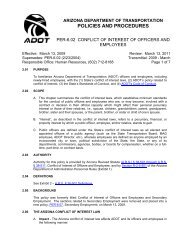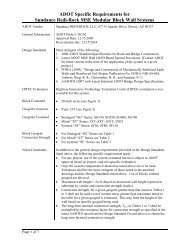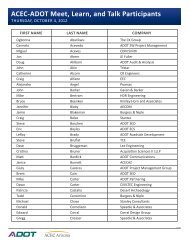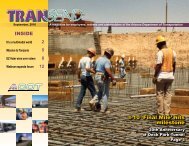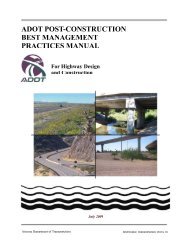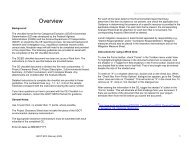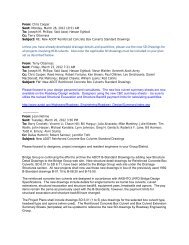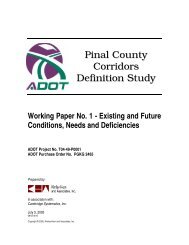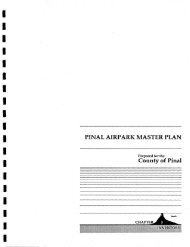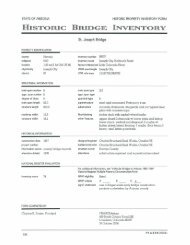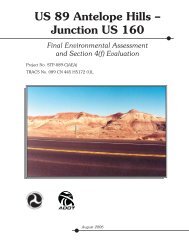I-10 Twin Peaks Traffic Interchange, Environmental Assessment
I-10 Twin Peaks Traffic Interchange, Environmental Assessment
I-10 Twin Peaks Traffic Interchange, Environmental Assessment
You also want an ePaper? Increase the reach of your titles
YUMPU automatically turns print PDFs into web optimized ePapers that Google loves.
Affected Environment and <strong>Environmental</strong> Impacts October 2005<br />
high value project habitat; and, reestablish desertscrub plant communities<br />
along the degraded upland portions of the Santa Cruz River corridor,<br />
emphasizing saltbush-wolfberry and mesquite associations as components.<br />
Conclusion<br />
Suitable habitat for the CFPO and the yellow-billed cuckoo is present in the<br />
project area within the Santa Cruz River Channel. Upland vegetation areas near<br />
Linda Vista Boulevard are also suitable habitat for the CFPO. The pygmy-owl and<br />
the yellow-billed cuckoo have been documented near the study area, although<br />
surveys for CFPO conducted in 2001, 2002, 2003, and 2004 have not detected<br />
pygmy-owls in the study area. Vegetation impacts in suitable habitat would be<br />
limited to riparian vegetation along the Santa Cruz River and desertscrub<br />
vegetation in upland areas along Linda Vista Boulevard and El Camino de<br />
Mañana. USFWS concurred that the Preferred Alternative would not jeopardize<br />
the endangered CFPO nor the yellow-billed cuckoo in a letter dated December 21,<br />
2004. The USFWS concluded also that the majority of the project area does not<br />
support CFPO nesting habitat and that, based on the proposed replacement of<br />
trees, habitat connectivity important to successful dispersal would be maintained<br />
or enhanced. Mitigation measures that would be implemented include a<br />
revegetation plan developed by the Town of Marana prior to removal of vegetation<br />
during construction.<br />
Arizona Species of Concern<br />
Species<br />
Wildlife of Special Concern in Arizona, as defined by AGFD, are species whose<br />
occurrence in Arizona is or may be in jeopardy, species with known or perceived<br />
threats, or species suffering population declines. One state listed species, the<br />
Fulvous whistling duck (Dendrocygna bicolor), has been documented by AGFD<br />
as occurring within 2 miles of the study area.<br />
Fulvous whistling duck<br />
Fulvous whistling duck are found along rivers, ponds, stock ponds, marshes, and<br />
swamps. This species has been documented by AGFD as occurring within two<br />
miles of the study area in the vicinity of the Santa Cruz River. Potential suitable<br />
habitat in the study area is limited to a small, narrow band of riparian vegetation<br />
along the Santa Cruz River that lacks sufficient vegetation cover and density to<br />
support fulvous whistling duck nesting. Fulvous whistling duck were not observed<br />
during a pedestrian survey of the study area.<br />
Impacts<br />
No Build Alternative<br />
The no build alternative would have no impacts upon Arizona wildlife species of<br />
concern in the project area.<br />
Interstate <strong>10</strong> <strong>Traffic</strong> <strong>Interchange</strong> at<br />
<strong>Twin</strong> <strong>Peaks</strong>/Linda Vista<br />
4-33<br />
Project No.: NH-0<strong>10</strong>-D (AIW)<br />
TRACS No.: <strong>10</strong> PM 236 H5838 01D



